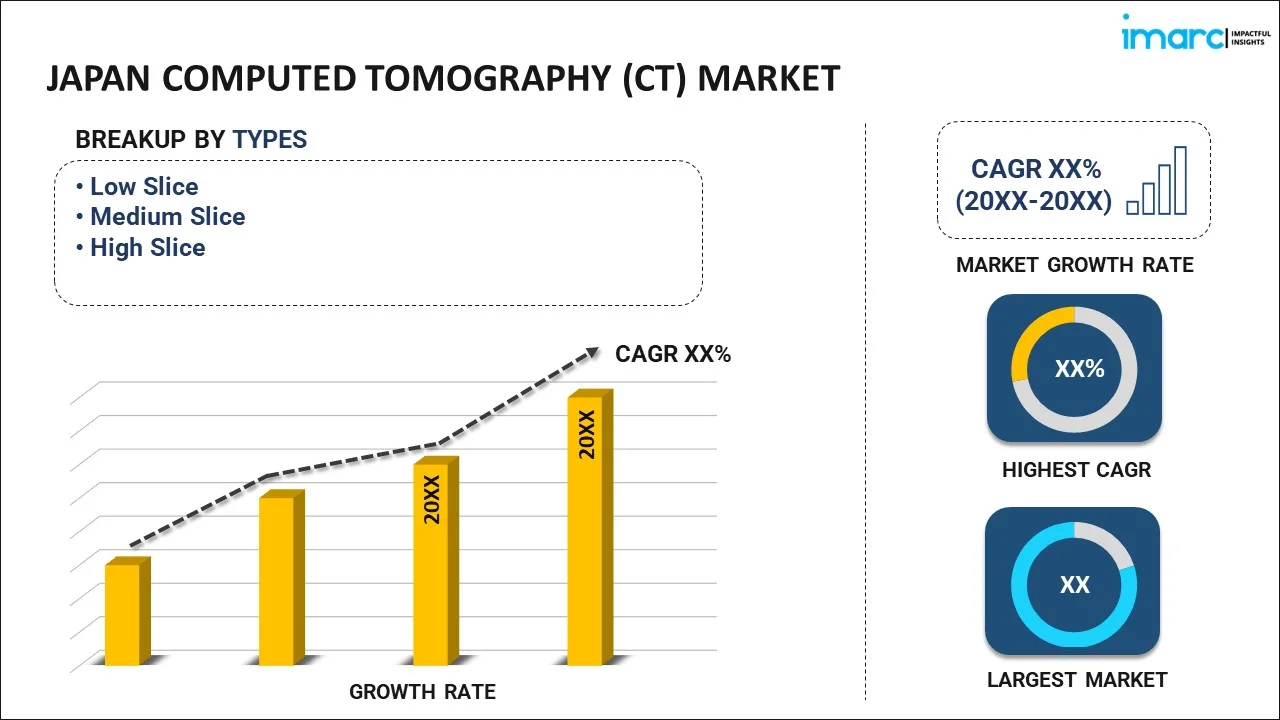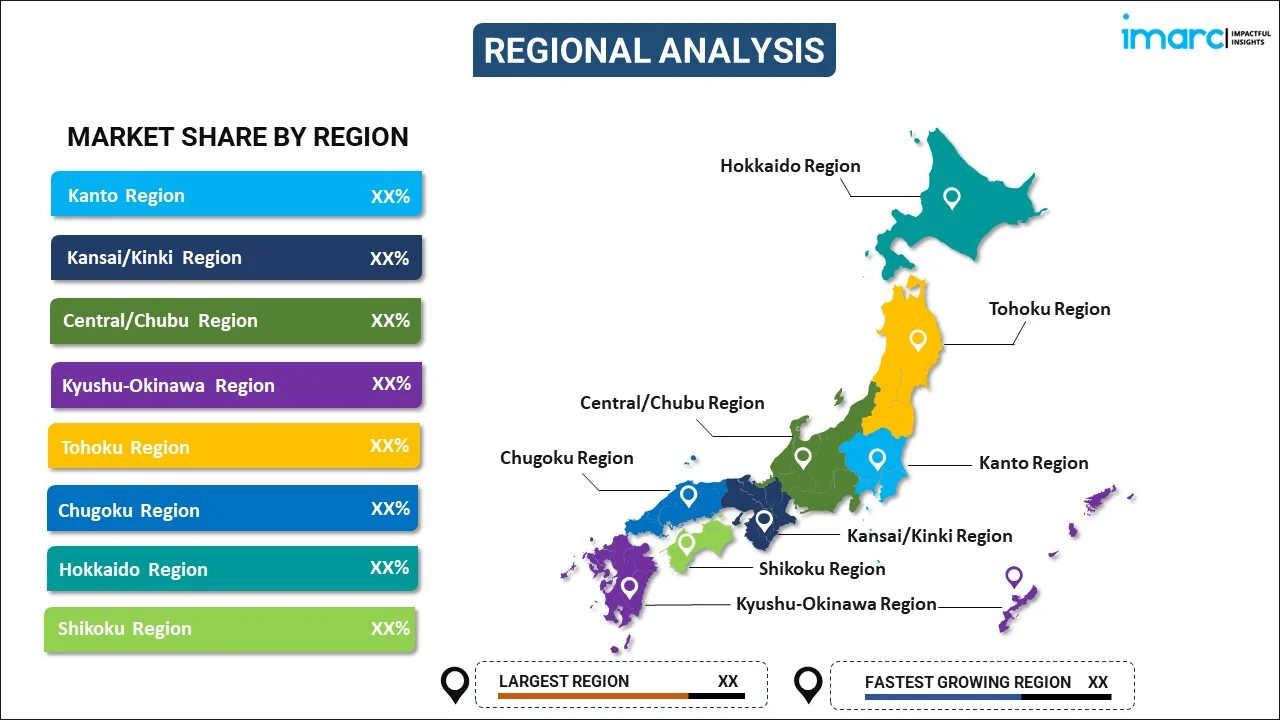
Japan Computed Tomography (CT) Market Report by Type (Low Slice, Medium Slice, High Slice), Application (Oncology, Neurology, Cardiovascular, Musculoskeletal, and Others), End User (Hospitals, Diagnostic Centers, and Others), and Region 2025-2033
Market Overview:
Japan computed tomography (CT) market size reached USD 460 Million in 2024. Looking forward, IMARC Group expects the market to reach USD 736 Million by 2033, exhibiting a growth rate (CAGR) of 5.4% during 2025-2033. The emerging popularity of portable CT scanners that are highly efficient, cost-effective, improve treatment processes, minimize transportation requirements, enhance overall patient care, and reduce risk, is positively influencing the market growth.
|
Report Attribute
|
Key Statistics
|
|---|---|
|
Base Year
|
2024 |
|
Forecast Years
|
2025-2033 |
|
Historical Years
|
2019-2024
|
| Market Size in 2024 | USD 460 Million |
| Market Forecast in 2033 | USD 736 Million |
| Market Growth Rate (2025-2033) | 5.4% |
Computed tomography (CT), originally called computed axial tomography (CAT), is a sophisticated imaging procedure that utilizes a combination of computer technology and X-rays to generate cross-sectional images (slices) of the body, including bones, blood vessels, and soft tissues. It involves the rotation of an X-ray tube around the patient, capturing multiple images from various angles, which are then processed by a computer to create detailed, 3D representations. These images offer a more comprehensive and precise view compared to conventional X-rays, allowing for improved diagnosis, treatment planning, and monitoring of diseases and conditions such as cancers, fractures, infections, and vascular disorders. CT is indispensable in emergency cases, like trauma assessments, where swift decision-making is crucial. The utility of CT scans extends to guiding surgical procedures and assessing the effectiveness of treatments, making it a pivotal tool in modern medical practice. Although highly informative, the usage of CT is moderated due to concerns regarding exposure to ionizing radiation, emphasizing the importance of justification and optimization in performing CT examinations.
Japan Computed Tomography (CT) Market Trends:
The market for computed tomography (CT) in Japan is propelled by the escalating prevalence of chronic conditions like cancer and cardiovascular diseases, which necessitates advanced imaging techniques for accurate diagnosis and treatment planning. Furthermore, the increasing incidents of accidents and traumas reinforce the indispensability of CT in emergency medical situations, thus contributing to market growth. Additionally, the relentless advancement in medical technologies is enabling the development of high-resolution CT devices that offer enhanced imaging, which is crucial in detecting minute anomalies, thereby broadening the scope and demand for CT. Moreover, the burgeoning aging population in Japan, who are more susceptible to various health conditions, is augmenting the market growth. A parallel driver is the growing healthcare expenditure and investments in medical imaging, reinforcing the availability and accessibility of CT. Apart from this, the increasing demand for CT scans in minimally invasive and robotic surgical procedures to pre-operatively screen patients and determine the risk of mortality and morbidity is expected to drive the computed tomography (CT) market in Japan.
Japan Computed Tomography (CT) Market Segmentation:
IMARC Group provides an analysis of the key trends in each segment of the market, along with forecasts at the country level for 2025-2033. Our report has categorized the market based on type, application, and end user.
Type Insights:

- Low Slice
- Medium Slice
- High Slice
The report has provided a detailed breakup and analysis of the market based on the type. This includes low slice, medium slice, and high slice.
Application Insights:
- Oncology
- Neurology
- Cardiovascular
- Musculoskeletal
- Others
A detailed breakup and analysis of the market based on the application have also been provided in the report. This includes oncology, neurology, cardiovascular, musculoskeletal, and others.
End User Insights:
- Hospitals
- Diagnostic Centers
- Others
The report has provided a detailed breakup and analysis of the market based on the end user. This includes hospitals, diagnostic centers, and others.
Regional Insights:

- Kanto Region
- Kansai/Kinki Region
- Central/ Chubu Region
- Kyushu-Okinawa Region
- Tohoku Region
- Chugoku Region
- Hokkaido Region
- Shikoku Region
The report has also provided a comprehensive analysis of all the major regional markets, which include Kanto Region, Kansai/Kinki Region, Central/ Chubu Region, Kyushu-Okinawa Region, Tohoku Region, Chugoku Region, Hokkaido Region, and Shikoku Region.
Competitive Landscape:
The market research report has also provided a comprehensive analysis of the competitive landscape. Competitive analysis such as market structure, key player positioning, top winning strategies, competitive dashboard, and company evaluation quadrant has been covered in the report. Also, detailed profiles of all major companies have been provided. Some of the key players include:
- Canon Medical Systems Corporation
- FUJIFILM Holdings Corporation
- GE HealthCare Technologies Inc.
- Koninklijke Philips N.V.
- Siemens Healthineers (Siemens AG)
(Please note that this is only a partial list of the key players, and the complete list is provided in the report.)
Japan Computed Tomography (CT) Market Report Coverage:
| Report Features | Details |
|---|---|
| Base Year of the Analysis | 2024 |
| Historical Period | 2019-2024 |
| Forecast Period | 2025-2033 |
| Units | Million USD |
| Scope of the Report | Exploration of Historical Trends and Market Outlook, Industry Catalysts and Challenges, Segment-Wise Historical and Future Market Assessment:
|
| Types Covered | Low Slice, Medium Slice, High Slice |
| Applications Covered | Oncology, Neurology, Cardiovascular, Musculoskeletal, Others |
| End Users Covered | Hospitals, Diagnostic Centers, Others |
| Regions Covered | Kanto Region, Kansai/Kinki Region, Central/ Chubu Region, Kyushu-Okinawa Region, Tohoku Region, Chugoku Region, Hokkaido Region, Shikoku Region |
| Companies Covered | Canon Medical Systems Corporation, FUJIFILM Holdings Corporation, GE HealthCare Technologies Inc., Koninklijke Philips N.V., Siemens Healthineers (Siemens AG), etc. |
| Customization Scope | 10% Free Customization |
| Post-Sale Analyst Support | 10-12 Weeks |
| Delivery Format | PDF and Excel through Email (We can also provide the editable version of the report in PPT/Word format on special request) |
Key Questions Answered in This Report:
- How has the Japan computed tomography (CT) market performed so far and how will it perform in the coming years?
- What has been the impact of COVID-19 on the Japan computed tomography (CT) market?
- What is the breakup of the Japan computed tomography (CT) market on the basis of type?
- What is the breakup of the Japan computed tomography (CT) market on the basis of application?
- What is the breakup of the Japan computed tomography (CT) market on the basis of end user?
- What are the various stages in the value chain of the Japan computed tomography (CT) market?
- What are the key driving factors and challenges in the Japan computed tomography (CT)?
- What is the structure of the Japan computed tomography (CT) market and who are the key players?
- What is the degree of competition in the Japan computed tomography (CT) Market?
Key Benefits for Stakeholders:
- IMARC’s industry report offers a comprehensive quantitative analysis of various market segments, historical and current market trends, market forecasts, and dynamics of the Japan computed tomography (CT) market from 2019-2033.
- The research report provides the latest information on the market drivers, challenges, and opportunities in the Japan computed tomography (CT) market.
- Porter's five forces analysis assist stakeholders in assessing the impact of new entrants, competitive rivalry, supplier power, buyer power, and the threat of substitution. It helps stakeholders to analyze the level of competition within the Japan computed tomography (CT) industry and its attractiveness.
- Competitive landscape allows stakeholders to understand their competitive environment and provides an insight into the current positions of key players in the market.
Need more help?
- Speak to our experienced analysts for insights on the current market scenarios.
- Include additional segments and countries to customize the report as per your requirement.
- Gain an unparalleled competitive advantage in your domain by understanding how to utilize the report and positively impacting your operations and revenue.
- For further assistance, please connect with our analysts.
 Inquire Before Buying
Inquire Before Buying
 Speak to an Analyst
Speak to an Analyst
 Request Brochure
Request Brochure
 Request Customization
Request Customization




.webp)




.webp)












